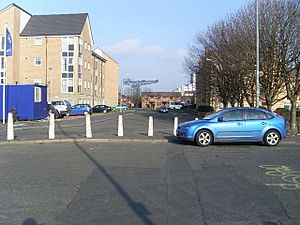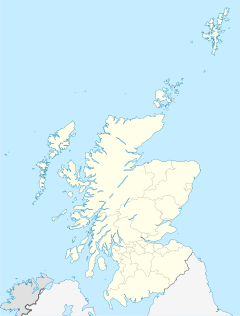Kinning Park facts for kids
Quick facts for kids Kinning Park
|
|
|---|---|
 Sussex Street |
|
| OS grid reference | NS571640 |
| Council area | |
| Lieutenancy area |
|
| Country | Scotland |
| Sovereign state | United Kingdom |
| Post town | GLASGOW |
| Postcode district | G41 |
| Dialling code | 0141 |
| Ambulance | Scottish |
| EU Parliament | Scotland |
| UK Parliament |
|
| Scottish Parliament | |
Kinning Park is a cool area in the south of Glasgow, Scotland. It used to be its own separate town, called a police burgh, from 1871 to 1905. After that, it became part of the big city of Glasgow. Back in 1897, about 14,326 people lived there.
Contents
Kinning Park's Past as a Town
Kinning Park started as its own small town in 1871. It was called a "police burgh," which meant it had its own local government. It was the smallest burgh in Scotland, only about 108 acres big.
For 34 years, Kinning Park had its own council, elections, and even its own fire and police departments! It also had a special court and a town hall. In 1905, it joined Glasgow. Another nearby town, Govan, was also a separate burgh for a long time before joining Glasgow in 1912.
When Kinning Park first formed its council in 1871, it was a big deal. Five "working men" were elected to the 12-member council. This was one of the first times ordinary working people had a say in local government in Scotland. A man named Andrew Boa, who was an activist, helped make this happen. This was even before the Scottish Labour Party was created in 1888.
During its time as an independent town, Kinning Park had nine leaders called Provosts. They were like the mayors of the town. The last Provost was Thomas McMillan, who served until Kinning Park joined Glasgow.
In more recent times, a building in Kinning Park became famous for political reasons. It's the Glasgow office for the Scottish Socialist Party (SSP). This building was where important meetings happened that led to disagreements between politicians.
What's in a Name?
A map from 1741 shows a field called "The Park" right next to a building called "Kinnen House." This is probably how the name Kinning Park came about as the area grew.
The word "Kinning" might come from an old Scottish word, "kinnen," which means "rabbit." This makes sense because a nearby area, Ibrox, is named after a Gaelic phrase meaning "badger ford." So, maybe Kinning Park was once a place with lots of rabbits!
There was also a long, grassy valley nearby called "The Cunyan." It was built over in the 1970s to make way for the M77 motorway.
The same old map also shows a field called "Plantation." This is likely where the name for the nearby area of Plantation came from. Some people thought it was named by a Mr. Robertson who owned land in the West Indies, but the map shows the name was used much earlier.
How Kinning Park Grew
Around 1850, Kinning Park changed a lot. It went from being a quiet village to a busy place. Many skilled workers and laborers lived there. The main jobs were in engineering, baking bread and biscuits, and making soap and paint.
Andrew Boa, the activist, also helped start the Kinning Park Co-Operative Society in 1871. This was a successful business that opened shops and factories in Kinning Park and other nearby areas. It lasted until 1952.
Today, Kinning Park is a district in Glasgow. It's on the south side of the River Clyde, about 1 mile (1.5 km) west of the city center. It's located between Kingston and Ibrox/Govan.
You can get there using the Kinning Park subway station. This station is the closest to the surface of all the stations on Glasgow's subway line. Now, Kinning Park has many small industrial businesses. Big media companies like BBC Scotland and Scottish Television moved their headquarters nearby to Pacific Quay between 2004 and 2008.
Cool Buildings in Kinning Park
Our Lady and St Margaret's Primary School is an old school building on Stanley Street. It was built in 1910 and designed by famous architects Bruce & Hay. The school closed in 1996–97. It's now a special "Category C(s) listed building" because it's a great example of a large school building.
The school even had a playground on its roof! This meant that sometimes tennis balls would fly over the wall and into the street. The building was later turned into offices between 2006 and 2010.
There used to be a very long apartment building (called a tenement) on MacLellan Street. It was said to be the longest unbroken building of its kind in Glasgow, maybe even the UK! But it was torn down to build the motorway. The street is still there, but it's now part of an industrial area. This area used to be home to a big iron factory called Clutha Works, which built bridges all over the world.
The architects Donald Bruce and Edward Hay designed many other unique buildings in Kinning Park. These included the Kinning Park Library (which was torn down in 1978), the Ogg Brothers' store (now called the "Angel Building" because of a large angel statue on top), and the Kinning Park Co-Operative Society stables, which had cool red and white bricks.
Kinning Park Complex: A Community Hub
The Kinning Park Complex is a special place for the community. It's a building that hosts many different activities to bring people together. It was originally built as a primary school in 1910. In 1976, it became the Kinning Park Neighbourhood Centre.
When the local council closed it in 1996 because it needed repairs, a group of people protested by staying in the center for 55 days! They eventually made a deal with the council to run the building themselves. Now, it's managed by a community group called Kinning Park Complex, and it's a busy place for everyone.
Sports History
Kinning Park is home to many pubs where people love football, especially the nearby team Rangers. Rangers actually used to play at a ground called Kinning Park ground from 1876 to 1887 before moving to their first Ibrox stadium.
Before Rangers, the Clydesdale Cricket Club used the ground for cricket in the summer and the new sport of football in the winter. Clydesdale, a football team from Kinning Park, played in the very first Scottish Cup Final in 1874! They lost to Queens Park. The Kinning Park football ground also hosted the Scottish Cup Final in 1881. Today, the M8 motorway covers where the old football ground used to be.
The M8 Motorway's Impact
The idea for the M8 motorway through Kinning Park was first suggested in 1945. When the motorway was finally built between 1970 and 1976, it changed Kinning Park a lot. A large part of the old area was demolished, and many people had to move to other parts of Glasgow or to new towns.
Famous People from Kinning Park
- The singer Mary Lee was born in a Kinning Park apartment building in 1921.
- The rock singer Alex Harvey, from The Sensational Alex Harvey Band, grew up on Durham Street in Kinning Park.
- His younger brother, Les Harvey, was also a musician. He started a band called the Kinning Park Ramblers with Maggie Bell. They later became the famous band Stone the Crows. Sadly, Les died at only 27 years old in a tragic accident during a concert in 1972.
Images for kids




